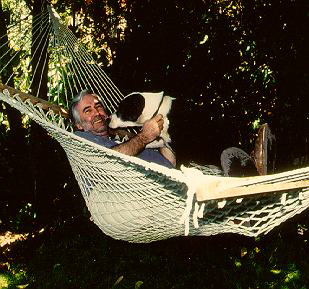Lifestyle Training

If you want your puppy to obey each family member in all settings and situations, then every member of the family must train the pup in every setting and situation. In order to teach your puppy to respond here, there, and everywhere, it needs to be trained here, there, and everywhere. The secret is to train your puppy little but often — at least fifty tiny training sessions a day — with only a couple of sessions lasting for more than a few seconds.
Integrate Training and Games
Playing games with lots of rules is a fun way to train your dog and exercise her mind. Your puppy will learn that games have rules and that rules are fun. Training becomes a game, and games become training.
Integrate Training and Lifestyle
In order to get your puppy to respond here, there, and everywhere, she needs be trained here, there, and everywhere. Train your puppy little but often. The secret is to totally integrate training into both your puppy's lifestyle and your lifestyle.
Train regularly and you'll discover that integrated training is easy and enjoyable. For example, call your puppy for a body-position sequence with variable length stays in each position whenever there are advertisements on the television, or every time you open the fridge, make a cup of tea, turn a page of the newspaper, or send an e-mail. If you instruct the pup to perform a simple body-position sequence on every such occasion, you will easily be able to train your puppy over fifty times a day without deviating from your normal lifestyle. Remember that you are responsible for a young, impressionable, developing canine brain. Exercise that doggy brain. Allow your pup to achieve and enjoy her full potential.
Integrate Training into Your Own Lifestyle
Once your dog is well-trained, she may enjoy full run of your house, will be welcome almost anywhere, and may eventually graduate to couch work. My dogs spend most of the evening snuggled on the couch. They like BBC America and Soccer (Arsenal supporters.) Occasionally, I may ask them to do something during breaks, like move over, fetch the paper, change the channel, vacuum the living room, or fix dinner. They're highly trained dogs.
Your Dog's Lifestyle
Integrate short training interludes (quick sits and releases) into your puppy's walks and off-leash play. Each quick sit is immediately reinforced by allowing the dog to resume walking or playing — the very best rewards in domestic dogdom. Integrate short training interludes into every enjoyable doggy activity — riding in the car, watching you fix their dinner, lying on the couch, and playing doggy games. For example, have your dog sit before you throw a tennis ball and before you take it back. Progressively increase the length of sit-stay with each repetition.
Similarly, insert short training preludes before all your puppy's enjoyable activities. For example, ask the pup to lie down and roll over for a tummy rub, or to lie down and stay a while before being invited for a snuggle on the couch. Have her sit before you put her on leash, before you open the door, before you tell her to jump in the car, before you allow her to get out of the car, and before you let her off-leash. And be sure to have her sit for her supper. With total integration, your puppy will see no difference between playing and training. Fun times will have structure, and training will be fun!
Life Rewards
Puppies are easy to train. It is so easy to teach them what we want them to do. In fact, a young puppy will do just about anything you ask just for the sake of doing it. As the puppy collides with adolescence, however, it begins to ask world-shattering questions, such as "Why?"
Just because your puppy has learned what "Sit" means does not necessarily mean she will sit when you request her to do so. Consequently, the most important ingredient of any educational program, whether for children, employees, husbands, or dogs, is teaching "Why comply?" You must teach the relevance of complying. Indeed, once you have taught your puppy the positive consequences of cooperating, she will eagerly want to comply!
First make a list of all the things in life your puppy enjoys. Then institute a simple and effective rule: Nothing will be denied, nor withheld from the pup, but the puppy has to sit beforehand. It's just common canine courtesy, really. Nothing more than a puppy "please."
In no time at all, your pup will learn the relevance of complying with your wishes and will be only too willing, eager, and happy to oblige. Now your dog will want to do what you want it to do.
Basically, you need to convince your pup that he or she is the trainer and you are the pupil! Your puppy needs to believe, "Sitting is the canine cue — the veritable key to the door — which makes my owners do anything I want. If I sit, they will open doors (how courteous). If I sit, they will massage my ears (how affectionate). If I sit, they will share the couch (how cooperative). If I sit, they will throw the tennis ball (how athletic). And if I sit, they will serve supper (how well-trained)."
Aside from producing a more reliable dog, integrating training into the daily routine of your dog makes your life more enjoyable, and allows your dog to have more fun and freedom. For example, something as simple as going through a door with an untrained and uncontrollable dog can be a time-consuming and daunting prospect. It can take some owners almost five minutes to put on the leash and make their exit. This means leaving the house with the dog just once a day may easily waste more than a whole fortnight over the lifetime of the dog. That's the equivalent of fourteen entire days and nights spent struggling with dogs in doorways. The result, of course, is that many owners do not bother to walk the dog at all if it's that much trouble.
On the other hand, well-trained dogs get to be taken on walks, picnics, days out, and car trips with their owners, and they are far less likely to be relegated outdoors, or isolated in a back room when visitors arrive. A well-trained dog has much more fun.
Settle Down and Shush
Right from the outset, make frequent little quiet moments part of your dog's daily routine. Remember, a puppy is not like an irritating child's toy. You cannot simply remove the batteries from a rambunctious adolescent dog. Instead you must learn how to "turn off" your dog. Learn to use walks and your puppy's favorite and most exciting games as rewards for settling down quietly and calmly.
Throughout the course of the day, have your puppy settle down for longer periods at home. For example, when watching the television, have your pup lie down on-leash, or in his bed, but during the commercial breaks, release the puppy for short, active play-training sessions.
When playing with your puppy, have him settle down and shush every 30 seconds or so. To begin with, have the pup lie still for just two seconds before letting it play again. Use a release command, such as "Free Dog," "At Ease," or "Let's Play." After 30 seconds, interrupt the play session again with a three-second quiet moment. Then try for four seconds. And then five, eight, ten, and so on. Alternate "Settle Down" with "Free Dog" and with each repetition, it becomes progressively easier to get your puppy to settle down quickly.
Once your pup gets the picture, the exercise may be profitably practiced on walks. When walking round the block, periodically have your puppy settle down for just a few seconds before resuming the walk. An entertaining way to train is to instruct your pup to settle down every twenty yards or so, while you read an article from the newspaper, or a page from a good book, such as Jean Donaldson's doggy bestseller, The Culture Clash.
With the above exercises, your puppydog will learn to settle down quickly following a single command, no matter how excited or distracted he may be. Moreover, your dog settles down willingly and happily because he knows being told to lie down is not the end of the world, and not necessarily the end of the walk. Rather, your dog has learned, "Settle Down" is just a relaxing time-out for gentle praise and affection before his exciting life as Mr. Activity Dog resumes once more.
It is difficult to have too many rules with an adolescent dog. Teach your dog to be calm and controlled when requested and there will be years of enjoyment ahead. Let your puppy pull on-leash, and it will pull on-leash as an adult. Let your puppy play indiscriminately and without frequent interruption, and it will become inattentive and uncontrollable as an adult. Integrate play and training, and integrate training and walks. In no time at all, training will be fun, and fun activities (play and walks) will be structured.
Adapted from AFTER You Get Your Puppy by Dr. Ian Dunbar




